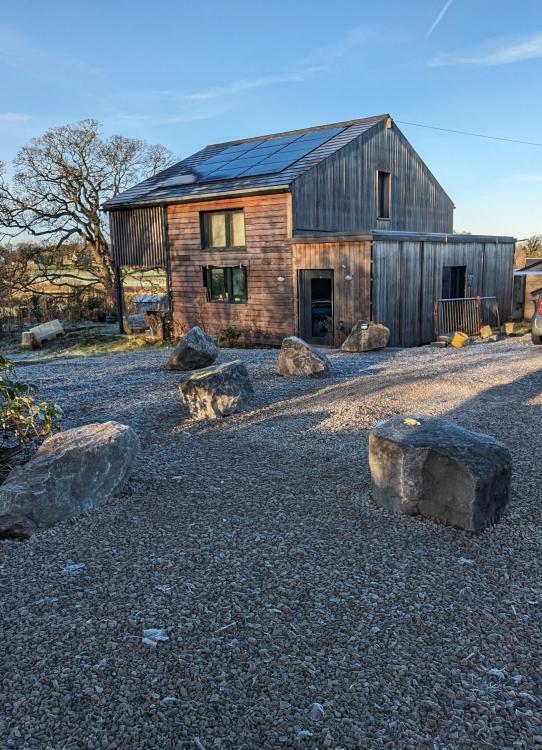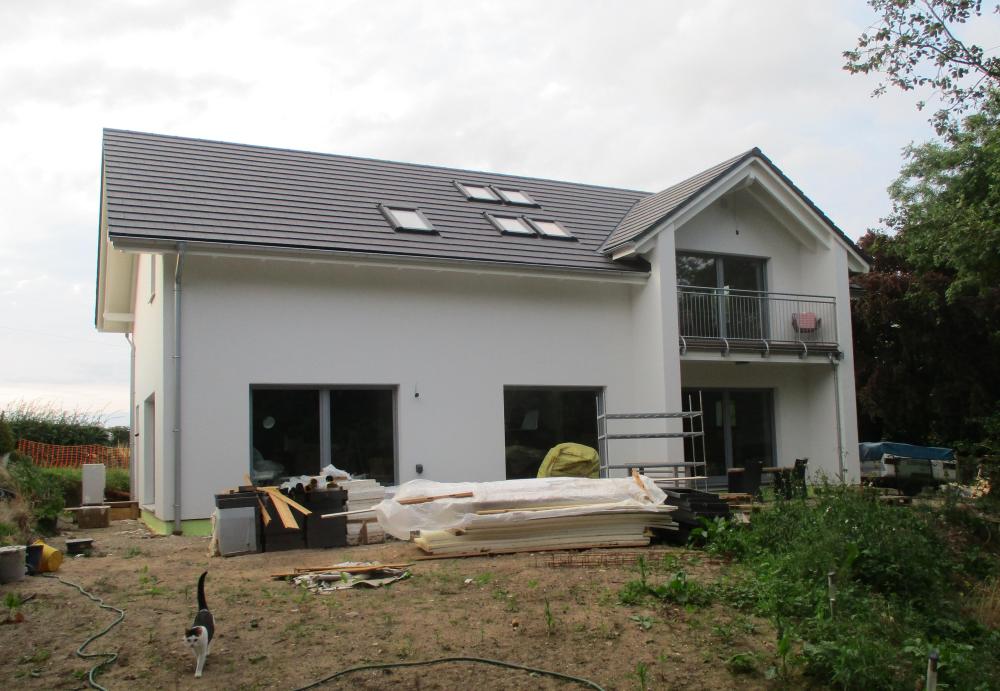Leaderboard
Popular Content
Showing content with the highest reputation on 07/26/24 in all areas
-
I hate these types of threads.....there is absolutely zero standardised way of quantifying this question. There are far too many variables in how folks achieve a self build and what they include in their costs to enable a like for like comparison. @nod is an absolute outlier and every time this question is raised pipes up about how little he has spent per m2 with no context to how that was achieved. Is land included in your cost there, i expect not, how much have you spent on labour throughout vs how much have you done yourself? There is not much to be saved on materials...shopping around and economies of scale will help but the margains for material cost savings are small compared to the savings which can be made if you eliminate external labour costs and are able to do the work yourself. Labour costs are the killer and individual self build costs per m2 are primarily determined by how much work they can actually do themselves. But it comes at a cost of time.7 points
-
Well this is entirely our original design but adapted for the DW system so they can do it (if you alter any of their standard designs by say moving a window it becomes "bespoke"). We omitted additional cladding due to cost and didn't do the glazed gable and fancy aluminium glazing as their system couldn't handle it. The interior is however exactly as we wanted. Sure there were compromises to make but we should be in, carpets laid and sitting on the sofa watching TV within 12 months of clearing the site and bringing on the static. We are both in our later 60's so didn't want a prolonged build on site, been there, done that. Garden to sort but can enjoy a warm modern house this winter after the last couple of renovations of old, cold "characterful" houses.3 points
-
Haha - I actually did it a few months ago, much closer to when I initially posted, but there was still a bit of a lag! Just tying up a few loose ends.....2 points
-
Like Joe90 we built to passive ideals but did not agree with certain aspects of the standard. In particular the need for and ASHP. The whole point of passive is a focus on energy reduction. A house built to them frequently doesn't consume enough energy to make and ASHP install sensible, the alternative of a low cost A2A makes more sense. Understanding the basics of passive build is fundamental to reducing inputs, certification isn't. I can't overstate the benefits of living in a house built on the passive principles, it's an incredibly comfortable living environment.2 points
-
Not at all, achieving the standard is not particularly difficult for the self-builder. Probably because the standard is very well considered, setting achievable targets for justified reasons that deliver a return. Certification is a personal choice. It does cost extra, but doesn't tell you anything about your home that you don't already know. Living in a PH house has given me more significant reasons as to "why", than I had when I chose to build one. I initially wanted reduced bills, I was building a long-term family home. Since the targets are significantly higher than Building Regs at the time, especially for a conversion, I did wonder if they'd be achievable and wasn't too concerned if I didn't quite get there. I also knew that I wanted more glazing than a PH house should really have. Through the Design phase the PHPP software really informed my decisions, and demonstrated where budget was best spent to achieve the overall building performance. The PH targets became my targets, as the PHPP software showed what changes were needed and didn't leave me guessing whether or not I had too much roof light area or not enough insulation. Had I just been building "better than regs", there are loads of minor changes I wouldn't have made, because I wouldn't have been using the tools that showed me exactly how the building would perform without those changes. While PH does deliver the low bills that I was after, the greater impact is comfort. I believe it's the lack of temperature gradients across rooms, with no perceivable convection currents, stable internal temps across the day, no perceivable air infiltration, the quietness of 3G glazing and while not specifically PH, the solidity of blown cellulose insulation gives rise to a comfort level I've not felt in any other building.2 points
-
PV is a different discussion so maybe best to separate from the ASHP one. Get people to survey and see what they say. Many seem to up size a few radiators, over size the heat pump, set the flow temp too high and install either a low loss header or buffer. Fill the house with thermostats and add as much inefficiency as humanly possible. 1. You want a heat pump closely matched to heat loss (plus allowing time to heat DHW) 2. A 3 port diverter valve A heat pump cylinder (big 3m² or bigger coil) 3. Radiators sized to allow as low as practical flow temp. Size bedroom rads to get to 18 degs or add trv's to these rads only. 4. ASHP controller You really need need nothing more for best efficiency.1 point
-
Not read the article (yet), but in the composite plastics world, fibres (usually glass, but can be organic or metallic) are added to reduce cracking. These fibres can be of varying length but generally no more than 12mm, but they are very thin, around 10 micron (10, 1 thousands of a millimetre, or 100thmm), but are generally bundle into 200 fibre 'lots'. This a more to do with the manufacturing of the fibres than any mechanical calculations. These are the same fibres that are used in CSM (chopped strand mat) but shorter, and usually without the chemical binder to hold them together. There has been attempts to injection mould polymers with these fibres in, but because of the flow characteristics, it has never been totally successful, so tends to be used in DMC (dough moulding compounds) and hand layup. They work by spreading out on the mould surface (or on the gelcoat) and fill small gaps and can allow for a 'resin rich' mixture which also helps fill voids. Once curing has taken place, they are locked in place, but because of the random positioning, they act as a good bridge between the exposed surface and the main reinforcement (usually CSM, weave or a core material). The same fibres are often used in concrete mixes to reduce micro cracking, but not excessive cracking caused by shrinkage (usually an incorrect concrete mix). I have never checked, but I suspect they work in the same mechanical manner i.e. helping to fill voids and micro-reinforcement. Short fibres/filaments/wires/rods are not there to make a non structural material a structural material, if the was the case, ropes and multi-strand cables would be made from very short lengths. If you look at an old suspension bridge, or boat's mast stay, you may notice that some of the wires in the bundle have come loose, but the bridge, or mast, is still in place. This is because there is a bit of a safety factor built in on the overall CSA (cross sectional area) tensile strength, but mainly because the side of the strands are adjacent to other strands, this causes resistance to movement (friction) which adds to the overall strength (and changes the failure characteristics). It is why they are twisted together. Because engineers (not the type of engineer that fixes your washing machine) are clever people, very small fibres can be made into sealed tubes, filled with a polymer. If there is enough movement, the fibre tube brakes, releasing the polymer, with then leaks out and fills the micro-crack, then the polymer hardens, restoring the mechanical properties of the material. (expletive deleted)ing clever that is.1 point
-
So decided to install a permanent TDS and Conductivity meter and use Litmus Paper for pH. The one I got from Amazon read a range of pH from 6.2 to 9.0 in 0.4 steps, so should be just fine. PH strips were £13 from Amazon TDS and Conductivity meter £72 delivered from https://www.osmotics.co.uk/lsm-100-commercial-grade-ec-tds-monitor.html?srsltid=AfmBOoqFcuTcWCe4eDl0kmA0H5AQqIF1z8Tk2OK6b2HGYpfNUt08T7Re 10" clear filter £25 Clear refillable resin insert £8 Some fittings £8 2x 1lt, £32. Total spend around £170. I will have in-line monitoring also within that cost, instead of having to drain a sample and test; so I can keep on top of the system very easily. The parts will be used as a filler unit first, via a flushing point, then modified to make a top up unit at the top up point. Total spend is around £70 cheaper than a cartridge top up unit from Viessmann Direct. And if I wanted a new cartridge they are around £140. Loose media is £16.1 point
-
I have a steel pipe in the same configuration - well actually slightly worse - I have three legs on it 1. Boiler (1m Max) 2. Old gas fire removed and pipe capped (5m Max) 3. Kitchen hob (2.5m Max) It's been like that since the house was built in 1980 - Having a suspended floor and access to underneath I can confirm there has been negligible external corrosion over the past 40 plus years However I've never had boiler cover other than a manufactures warranty (same goes for any other electrical appliance where "extended cover" is available. I effectively self insure I divert a small sum every month to building society account to cover repairs/replacements for anything that breaks. As a result next week I'm replacing my boiler (which is 15 years old) before it fails - I'm not having to fund it on a credit card - it's a well researched choice (my current boiler was probably a poorly researched choice at the time) and is coming out of the "household fund" I've also previously done the same with pet insurance which is always a battle to keep to an affordable level as pets get older (although I recognise that this is probably a higher risk process) It's quite surprising how much people do pay on appliance cover - my neighbour does everything that way and he said his monthly cost was £260 - I put away £100 a month and it seems to work for me I may reduce that once I've paid the balance on the boiler replacement as it'll have a 10 year warranty but as it's going to be down to £550 (ish) I may keep it the same till it's built up above £1000 again1 point
-
There's a common misconception that components must be certified individually if you want to achieve an overall certification. That's not the case. They just need to meet the minimum requirements for that component class. According to the Passivhaus Institut, while it is strongly recommended to use Passivhaus-certified components due to their guaranteed performance, it is not strictly mandatory for all components to be individually certified. The key requirements focus on the overall performance of the building rather than the certification status of every individual component.1 point
-
Yes. In a structural slab the cross section of steel is what resists the shrinkage, and in a structural wall or slab the cross section is chosen to provide the tensile strength required. But by using more bars of smaller diameter, at close centres, adding up to the same sort of c/s , the cracks can be made smaller ( in both directions) This was a very long time ago but I think I selected small mesh and tied lots of small bars to it, for ease of construction. If it works, then the tiny cracks are not visible. I expect they do 'heal' as a bonus. I probably specified concrete with smallish aggregate to ensure it flowed around all those bars. I hope the concrete was poured without extra water added on site, or it would defeat the object.1 point
-
If either the Lux battery inverter cannot export at all or it can be set and locked to a zero export setting you need to reply with details of this and e.g. screen shots of the relevant settings, maybe this needs to be on a separate G100 Export Limit application, look up G100 on the UKPN web site. Then if you make a new application to export up to 10.25 kW they should grant it. This website is unfortunately not very helpful but the camelot forum has other Lux users I think, try there. If the Lux can't be restricted to no export then you are looking at third party equipment which can get expensive, or downrating your PV to the difference i.e. 6.65 kW.1 point
-
As an update, what I did was: - Applied a blob (2cm) of BT1 to base of shower frame beneath door hinge (with hindsight I would probably have added a bit more, but it's still sturdy several months later) - Inserted shower frame into channel: Bottom corner first at a slight downward angle and push down as far as it will go (still at an angle) Aligned gap beneath door hinge with runner already attached to tray and pushed downwards Forced the rest of the frame into the channel (and prayed that the glass didn't explode) Pushed down from top as it wasn't flush with the top of the channel Placed a piece of wood on the top part of the frame inside the channel, and hit with rubber mallet until flush with top of channel (more praying required) Inserted screws into channel & door frame, but didn’t fully tighten yet (NB - this is what I should have done - what I actually did was fully tighten in the first instance, and had to untighten after attaching the door) Attached window bracing - Then lifted door onto hinge and ensured it is correctly aligned on both side - Placed top door hinge cap and inserted 2 screws & tightened NB - I fully tightened the channel screws and then placed the door on the hinge. An hour later, thinking that I maybe should have let the shower tray take the weight of the door, I loosened the screws slightly and retightened 24hrs later. With hindsight/common sense, I wouldn't have fully tightened in the first place, and would have waiting 24 hours. Posting in the event that someone encounters something similar.1 point
-
1 point
-
I have skim read this but may try again. In case it is of any interest here is my experience. I have designed large, above ground, water tanks for industry and for a hospital. I recall they were about 3m deep. Both were built and I heard no more, so I think they worked. The design codes at the time covered how to control the cracking. Maybe the codes have changed but it worked back then, and concrete will still behave the same way. Basically we used a lot of small reinforcing bars, so that the inevitable shrinkage resulted in micro-cracking.... millions of cracks that are too small to see, and water can't get through. Did it heal? Probably. These tanks could have been sealed on the inside but were not. The evaporation of water was not considered an issue, and perhaps that causes 'healing' as water soaks through. For a garage or other basement, the water is on the outside and it would be easy to tank the inside, but it might come off. A big basement I recall doing, we tanked the outside of the wall and slab using a bentonite filled sheeting.1 point
-
When you re-pressurised it, did you bleed all air out? Make sure all air valves are open as trapped air can also cause flow rate issues.1 point
-
OK here's a few numbers - from my window schedule in PHPP nominally using Rationel Auraplus & Velux. S/W/E windows using Rationel Sun SKN176; N wndows using Rationel Auraplus 4/20/4/20/4; Veluxes using Velux Heat Protection Glazing 69: Average Uframe=1.132, Uglazing=0.522, Uwindow=0.712, Uinstalled=0.822 If I change all the glass for better stuff with 90% of the U-value (e.g. 0.5 glass becomes 0.45 glass etc), the numbers become: Average Uframe=1.132, Uglazing=0.470, Uwindow=0.675, Uinstalled=0.785 So, sounds like the Uwindow/Uglazing factor (the discrete derivative? ) might be around (0.712-0.675)/(0.5-0.45) i.e. 74%. Hope that helps . I guess you can also sometimes get this from the window frame supplier's various double/triple glazed offerings - if you believe their numbers... You can play these type of games fairly easily by mangling PHPP if you choose to.1 point
-
Have you tried powering down and back on again? Sometimes changes are not detected until you do this. Also could this video help - includes remedial steps you may be able to do yourself1 point
-
Has your system been maintained annually? If yes then I would contact Mitsubishi directly and explain the situation. They may send one of their engineers directly to you and resolve under warranty.1 point
-
Beautiful image. We used stainless steel screws - increased the cost of our cladding mostly paid in the extra time it takes.1 point
-
Too many people get over excited about the latest developments in PV, they have stayed the same for decades. There is not much room for efficiency gains from silicone, though other chemistries are available.1 point
-
1 point
-
We are moving into our second build today Both well insulated Like forever home It’s just a label and will mean more to you than any future buyer I would make sure that you are happy with the rest of the build your main priority We fought planners on both occasions over trying to make us have PV ruining the look of our slate roof If I was to go down the route of Passive I definitely wouldn’t pay for someone to give a certificate telling me what I already know1 point
-
The Laws of Thermodynamics makes it is technically easy to build a low energy usage house, they will just not look very nice i.e. square floor plan, small windows, thick walls, and loads of MVHR pipework in the loft. The CO2e part is really out of peoples control, that is down to the nation's generation mix, which makes the statement about designing a house that used x amount less a bit of a nonsense. OK you can stick as fair amount of PV on a roof, and you should, but that only lowers the local CO2e volumes produced, does not make much difference to the globe.1 point
-
I built to passive principles, probably not actually achieving a “pass” and had no intention of getting certification. The driving principle for me was a comfortable house that was affordable. My thought was if I ever sold the house showing how cheap it was to run would have more clout than a certificate that most buyers would not even understand. Even now i believe a lot of buyers take very little notice of the EPC rating (presuming it’s accurate which I believe a lot are not!!!!).1 point
-
For the last couple of years, every time I've finish a box of pozis, I've replaced them with the torx equivalent. They're just so much more pleasant to use.1 point
-
I have been having similar experience / frustrations with obtaining quotes for ashp. We are currently heavily renovating / extending a 1960's detached property. It is now circa 150m2 ground, 100m2 1st floor. All floors have been dug out and then new slab, insulation, underfloor (16mm @ 200 centres) , liquid screed etc. We have also installed overlay underfloor on 1st floor but only ground floor heating active at moment and bedrooms fine with no heat. Majority of walls are Plasmor Fibolite (0.24 - brilliant blocks) on internal and external skins, 100mm cavity with 75mm insulation, air tight parge coat and then 40mm closed cell xps foam board glued to block and then plasterboard glued to insulation. Roof is warm with 300mm pir insulation under osb skin. We also have mvhr being installed - project on going. Triple glazed Internorm Passive level windows and doors throughout. Basically aiming for as close to Passive i.e. lots of attention to sealing everything. The generic heat pump suppliers don't seem to take much of this into consideration and seem to be able to do a heat loss in a few mins with a couple of questions. Heat loss comes back around 11Kw, I challenge this and say our existing 19kw viessman boiler runs at 35mm flow and majority of the time modulates down to around 20% i.e. 3.8kw Personally I would like to install a Vaillant 7kw hp but nobody will budge. I have also built house with heat pump in mind and have already installed with brand new 28mm copper flow and return to boiler, heat pump would be fitted the other side of the cavity wall to where boiler is now, electrics are also in as is the 2 core comms cable, we have an existing 250 litre UVC in loft, so a really simple job. Quotes are coming in at around £14k before grant. When I challenge them about max 2 days on site for literally £7k of labour they just say " thats the way it is " I have recently found a company that do MCS installs under an umbrella scheme. They do the calcs, specify heat pump, do the grant application etc but then let your local plumber or even the self builder to install the system. They then commission it afterwards. just waiting on quote but keeping fingers crossed that this is a common sense approach and much more cost effective approach for may people who are self building etc - They are called Alto Energy1 point
-
I don’t see why the government should pay for you to upgrade your draughty 1930’s house because you haven’t done anything to it in the last 20 years. People need to be a bit more responsible for themselves. All a grant will do is manufacture loads of new crappy insulation companies1 point
-
Induction hobs are so much better than gas hobs. Do you do the same calculation on a gas boiler? Or just assume because it is a bit cheaper to install, it must be a better return. I don't know of anyone that does an ROI on a holiday, or bathroom.1 point
-
I think you'd be looking at least £400. For no benefit what so ever. I'd be ditching the cover and start putting money away each month towards an eventual boiler replacement / breakdown in 5-10 years time. I've never seen the value in these sort of polices, I've never paid more than £50 for an annual inspection / service and the only issue I had in a boiler in nearly 15 years cost £200 to sort.1 point
-
Presumably you have the bells and whistles policy that covers leaks etc from the pipework as well as the boiler itself? And presumably the existing provider will still cover the boiler/controls/radiators etc if it breaks down, they're just saying if the steel pipe fails they won't fix that? And there's no particular reason to think the steel pipe will fail now - there's no obvious corrosion or damage - the insurer has just made a blanket change to their terms? If all that is correct, I would personally probably just stay on the current policy and accept that length of pipe is not covered. If it does fail, you will have to get it repaired / replaced at your cost - but that would probably not be much different to the cost of doing that now. And my gut feel (not a gas plumber, perhaps steel pipes are riskier than I assume) is that is probably quite unlikely anyway, if there's no history of issues. Seems to me there's 3 possible scenarios: * You pay now to replace it to keep it insured, your brand new copper pipe is very unlikely to need insurance work in the near future, so might as well not be insured. * You leave it, nothing happens, no cost. * You leave it, it fails in future, cost to repair/replace when it happens probably not that different to what it would cost now. The only one of those that costs you more is upgrading the pipe now, for no real benefit. And it likewise doesn't seem worth paying £400 a year more for a policy just to cover that length of pipe. I would put some money in a savings account and deal with it if it becomes a problem, or when you're doing other work e.g. changing flooring / decorating (making good could be a big part of the cost if you do it as a standalone job).1 point
-
17 years after we finish our build our warranty paperwork will have long since been firelighters, the faded PassiveHaus Certificate will still be proudly displayed in the hall in the vain hope that it’ll help the valuation for the lifetime mortgage which we will need to replace the old wheeled campervan with a new thermonuclear (food waste based) powered hover van with integral health suite and coffee maker. You never know, PH might become trendy and help sell in the future…0 points










.jpg.c21f3ac78c9b7efd90cbdcb312744dc5.thumb.jpg.7adcad4c0e384f5ecd7d56b0618df6e5.jpg)


